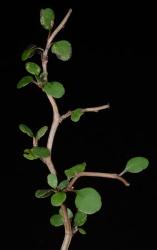- Taxon
- Gallery
Shrub up to 2.2 m tall, with an open habit. Branches upright to spreading, outer bark light grey to light grey-brown, smooth on young branches, becoming light brown, rough, and longitudinally furrowed on old branches; branchlets slightly to prominently flexuose, 2.0–3.0 mm diam., light brown to cream-brown, slender, terete, glabrous to sparsely hairy, diverging between 20° and 40°, nodes up to 30 mm apart; brachyblasts sometimes present, up to 10 mm long. Leaves alternate, lamina 3.2–13.4 × 3.1–11.5 mm, broadly elliptic to ± orbicular, with cream to occasionally fulvous T-hairs; abaxial surface densely hairy; adaxial surface dull green, often red-purple toward base, sparsely hairy to glabrate; midrib and main lateral veins prominent on both surfaces; base cuneate to obtuse; margin sometimes slightly undulate, usually red-purple, with (2–)5(–7) teeth that are surrounded by prominent red-purple blotches; apex obtuse; petiole 1.7–8.5 mm long, sparsely to moderately hairy, or glabrate. Capitula 3–5 per corymb; inflorescence moderately to densely covered with appressed T-hairs, rachis 2.8–26.0 mm long, pedicels 1.1–16.0 mm long; bracteoles subtending each capitulum, 1.0–2.4 × 0.3–0.8 mm, spathulate, narrowly lanceolate to linear, apex subacute to obtuse, base cuneate, sparsely to moderately hairy on both surfaces. Involucre conical in bud, cylindric at maturity. Involucral bracts 13–18, 3–4-seriate, patent at maturity; midrib and central part of adaxial and abaxial surfaces green, outer part of adaxial and abaxial surfaces red to pink-red, abaxial surface of outer bracts with hairs on midrib, abaxial surface of inner bracts glabrous, adaxial surfaces glabrous; apices acute to subobtuse, usually with a distinct tuft of hairs; margins fimbriate or hyaline-fimbriate in distal part; bases cuneate to attenuate; outer bracts 0.8–1.3 × 0.3–0.6 mm, broadly elliptic to shortly lanceolate; inner bracts 3.1–4.2 × 0.7–1.0 mm, lanceolate. Florets 3–8 per capitulum. Female florets 2–4, limb white, 4.2–4.3 × 0.7–1.3 mm, glabrous; tube 2.1–2.8 mm, sparsely hairy. Hermaphrodite florets 1–4, actinomorphic; corolla usually with glandular hairs near apex; lobes 5, 0.6–0.8 × 0.3–0.4 mm, narrowly triangular, deflexed at maturity, white; tube 3.4–3.6 mm long, sparsely hairy. Anthers 1.7–1.8 mm long; apex apiculate, 0.3–0.4 mm long; tails 0.1–0.2 mm long; filaments 1.4–1.7 mm long, glabrous. Style of female and hermaphrodite florets 3.0–3.1 mm long; style arms 1.1– 1.5 mm long, cream; ovary 0.9–1.3 × 0.3–0.4 mm, moderately covered with eglandular hairs; pappus bristles scabrid, 2.0–4.0 mm long. Cypsela narrowly oblong, somewhat compressed and angular in section, 2.0–2.3 mm long; base obtuse; ribs 5, narrow, raised. Surface smooth, henna to red-brown, moderately covered in white antrorse eglandular hairs. Pappus 2.5–4.3 mm long, pale orange-yellow. FL Oct–Jan; FR Jan–Apr.
[Reproduced from Heenan (2005, New Zealand J. Bot. 43: 753–766) with permission from The Royal Society of New Zealand.]




